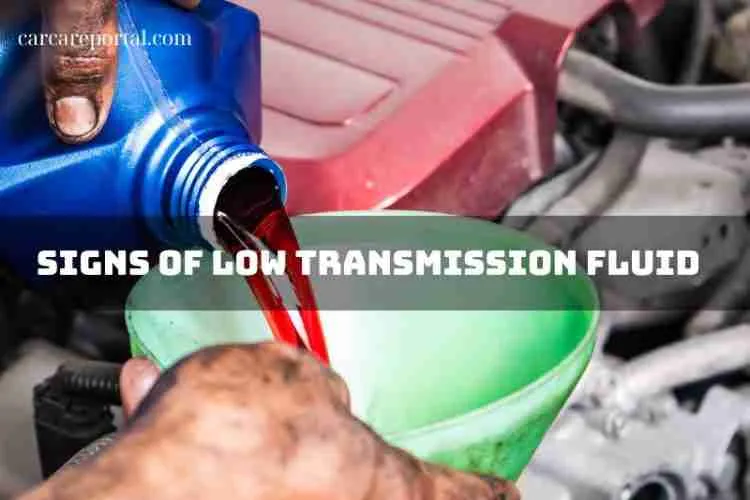Signs of Low Transmission Fluid: An Essential Guide for Vehicle Owners

Maintaining optimal transmission fluid levels is crucial for the smooth operation and longevity of your vehicle’s transmission system.
However, it’s not uncommon for drivers to overlook this vital aspect of vehicle maintenance. Low transmission fluid can lead to a range of problems, from minor inconveniences to major mechanical failures.
Recognizing the early signs of low transmission fluid can save you from expensive repairs and ensure a safer driving experience.
In this guide, Carcareportal will delve into the key indicators that signal low transmission fluid, helping you stay informed and proactive in your vehicle’s maintenance.
Whether you’re a seasoned driver or new to vehicle ownership, understanding these signs is an essential step in ensuring your vehicle’s health and reliability.
What Does a Transmission Do?
The transmission is a vital component in a vehicle, functioning as the power distributor from the engine to the wheels. It ensures that the wheels receive the right amount of power, allowing them to move at varying speeds. This variation in wheel speed is referred to as “gears.”
There are primarily two types of transmissions in modern vehicles:
Manual Transmission: This is less common in newer vehicles but can be found in older models. It requires the driver to manually change gears using a stick shift, often in conjunction with a clutch pedal.
Automatic Transmission: This is the more prevalent type in today’s vehicles. In an automatic transmission, the process of gear shifting occurs seamlessly and automatically based on the vehicle’s speed, requiring no manual input from the driver to change gears.
What Is Transmission Fluid?
Transmission fluid is essential for the smooth functioning of both manual and automatic transmissions in vehicles. It plays a crucial role in reducing the wear and tear of the transmission by lubricating its moving parts, such as bearings and metal components. This fluid not only eases the gear-shifting process but also contributes to several other key functions:
- Assisting in the operation of the torque converter.
- Facilitating the operation of the valve body.
- Aiding in the functioning of clutch friction.
- Helping with brake band friction.
- Contributing to the cooling of the transmission system.
Transmission fluids are available in two main types, tailored to the kind of transmission they serve:
- Automatic Transmission Fluid (ATF): This is commonly used in a variety of vehicles, regardless of the transmission type. ATF is usually a thin, clear fluid with a red tint, although it can vary in color based on the manufacturer’s specifications.
- Manual Transmission Fluid: This type is generally thicker and darker compared to ATF. It’s predominantly used in older vehicles with manual transmissions.
10 signs of low transmission fluid
Detecting Low Fluid Level: Regular checks of your transmission fluid using the engine’s dipstick are crucial. If you find the fluid level below the recommended line, it’s time to refill.
Transmission Slipping: If you notice your gears slipping or if the vehicle is shifting erratically, it could be a sign of low transmission fluid. This requires immediate attention to avoid potential damage.
Hearing Unusual Noises: Unusual sounds like clanking or grinding from your transmission suggest that critical components might be rubbing due to inadequate lubrication. It’s essential to replenish your fluid promptly.
Noticing an Unpleasant Odor: A distinct, sweet scent characterizes transmission fluid. If it smells burnt or unusual, it’s a sign that the fluid level is low and possibly overheating.
Spotting Puddles under Your Vehicle: If you find a bright red, translucent puddle under your car, it indicates a transmission fluid leak, necessitating immediate repairs.
Experiencing Overheated Transmission: An overheating transmission, often accompanied by a burning smell or smoke, is a major indicator of low fluid levels.
Observing Delayed Gear Shifts: A noticeable delay when shifting gears can indicate insufficient hydraulic pressure due to low transmission fluid.
Feeling Irregular Shifts: If gear shifts are abrupt or irregular, it may be a sign that the transmission fluid is too low.
Facing Inability to Shift Gears: A complete inability to shift gears could mean a total lack of transmission fluid.
Dealing with Transmission Failure: Continuous problems despite refilling the fluid may indicate the need for transmission repair or replacement. It’s advisable to consult with a service team for a thorough checkup.
Causes of Low Transmission Fluid
Transmission Fluid Leak: This is the primary reason for a reduction in transmission fluid. The leak could be due to various issues, such as deteriorated seals, faulty gaskets, or damage to the transmission pan. These leaks can be small and gradual or large and rapid, leading to a significant decrease in fluid levels.
Evaporation: Over time, it’s normal for some level of transmission fluid to evaporate. However, this is usually a slow process. A sudden and noticeable drop in the fluid level is typically not just due to evaporation and often signals a more serious problem.
Incorrect Fluid Levels Post-Maintenance: Sometimes, after maintenance or repair work involving the transmission system, the transmission fluid may not be refilled properly. If the fluid isn’t topped up to the required level, it can lead to issues associated with low fluid levels.
Potential Engine Components at Risk
When the transmission fluid in your vehicle is low, it can adversely affect several crucial engine components, leading to potential issues and damage. These components include:
Gears and Clutches: Low fluid levels can increase friction and wear on the gears and clutches. This can result in poor shifting performance and may even cause significant damage to these components.
Torque Converter: The torque converter is a vital component in automatic transmissions. Insufficient transmission fluid can lead to overheating and premature torque converter wear.
Transmission Bands: These bands are critical for maintaining gears in their proper position. These bands may slip when fluid levels are low, causing improper gear engagement and potentially leading to transmission damage.
Valve Body: The valve body controls the flow of transmission fluid and directs hydraulic pressure. Low fluid levels can cause the valves to stick or malfunction, affecting the transmission’s performance.
Solenoids: Solenoids are essential in managing the flow of transmission fluid for smooth gear shifting. If the fluid level is low, it can impede the operation of solenoids, resulting in rough shifting or gear slippage.
Transmission Pump: This pump depends on the transmission fluid for lubrication and cooling. A lack of adequate fluid can increase pump wear and decrease efficiency.
Seals and Gaskets: Low fluid levels can cause the transmission to overheat, leading to the deterioration of seals and gaskets. This degradation can cause leaks, leading to further loss of transmission fluid.
How Long Should Transmission Fluid Last?
The life expectancy of transmission fluid can vary based on driving conditions, vehicle type, and fluid used.
Typically, automatic transmission fluid (ATF) should be changed every 30,000 to 60,000 miles.
It’s critical to refer to your vehicle’s manual for specific recommendations from the manufacturer regarding service intervals.
Repairing Transmission Fluid
Check Fluid Levels: First, locate the transmission dipstick in your engine (usually clearly marked) to assess the fluid level. If the fluid is below the recommended mark, you need to top it up.
Identify and Repair Leaks: If you suspect a leak, inspect the transmission and its vicinity for any signs of fluid leakage. If you find a leak, it’s imperative to address it immediately. This may involve replacing worn seals or gaskets.
Transmission Fluid Replacement: In situations where the fluid level is critically low or the fluid is contaminated, it’s often best to get the transmission fluid replaced by a professional.
Consult a Mechanic: If you’re not confident in diagnosing and handling issues related to transmission fluid, it’s advisable to seek assistance from a qualified mechanic. They can provide an accurate diagnosis and undertake the necessary repairs or maintenance.













No Comment